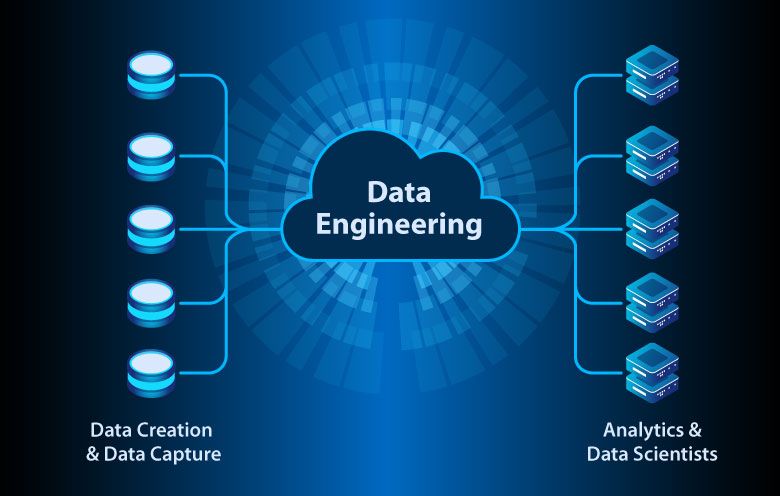As we move into the digital age, data is not just a byproduct of business; it is now a strategic tool. Data is being used more and more by businesses in all fields to make decisions, create unique experiences, and spark new ideas. But raw info by itself isn’t very useful. Businesses need solid ways to gather, process, and move data between different platforms and apps in order to get the most out of it. This is where data pipeline building is very important.
What Is Data Pipeline Engineering?
At its core, data pipeline engineering involves the design, development, and maintenance of systems that transport data from one location to another, typically from source systems (like applications, databases, or sensors) to destinations such as data warehouses, analytics platforms, or machine learning models.
A well-designed data pipeline ensures that data is gathered in real-time or at scheduled intervals, transformed into a usable format, and delivered to its destination reliably and efficiently. This end-to-end process includes data ingestion, transformation, enrichment, validation, and storage—each step critical to maintaining the quality and usability of the data.
Why Data Pipeline Engineering Is Central to Modern Data Strategy
As businesses generate and interact with increasing volumes of data, the complexity of managing this data also grows. Modern data strategies are no longer just about collecting data—they are about making the right data available to the right systems at the right time. This demand can only be met with robust, scalable, and intelligent data pipelines.
1. Enabling Real-Time Decision-Making
Modern businesses often operate in environments where speed is critical. For example, fraud detection systems in finance or ad bidding engines in marketing rely on real-time data to function effectively. Data pipeline engineering supports streaming data architectures that allow for continuous data flow, enabling up-to-the-minute decision-making and responsiveness.
2. Ensuring Data Quality and Integrity
Data quality is foundational to any data-driven initiative. Poor data leads to poor decisions. Effective data pipeline engineering incorporates validation and error-handling mechanisms that catch inconsistencies, missing values, and anomalies before the data reaches business intelligence tools or machine learning models. This ensures that data consumers—whether human analysts or automated systems—work with accurate, reliable information.
3. Scalability Across Systems and Volumes
As organizations grow, so do their data needs. Data pipelines must be designed to handle increasing data volumes, more complex transformations, and new data sources. Scalable pipeline architectures allow businesses to evolve without overhauling their infrastructure. Data pipeline engineering makes it possible to scale operations horizontally by leveraging modern tools like Apache Spark, Kafka, and cloud-native services.
4. Supporting Cross-Platform Integration
Most organizations use a variety of tools and platforms—CRMs, ERPs, custom applications, cloud services, and more. Data pipeline engineering ensures seamless integration between these systems. Whether it’s syncing customer data between platforms or feeding unified data into a data lake, pipelines bridge the gap between disparate technologies, fostering a more connected and intelligent enterprise.
Key Components of Effective Data Pipeline Engineering
To build a successful data pipeline, engineers must consider several critical components:
- Ingestion Frameworks: Mechanisms for pulling data from multiple sources, including APIs, databases, logs, and external systems.
- Data Transformation: Processes such as parsing, cleaning, normalizing, and enriching data to make it suitable for downstream use.
- Orchestration: Scheduling and coordinating pipeline processes using tools like Apache Airflow or Prefect to ensure workflows run in the correct order and on time.
- Monitoring and Logging: Systems that track pipeline performance, catch errors, and provide insights into data flow and health.
- Security and Compliance: Ensuring data is encrypted, access is controlled, and pipelines comply with regulatory standards like GDPR or HIPAA.
The Business Impact of Data Pipeline Engineering
Investing in data pipeline engineering is not just a technical decision—it’s a strategic one. Organizations that prioritize robust pipeline infrastructure are better positioned to leverage analytics, deliver personalized experiences, and stay competitive. Conversely, businesses that neglect their data infrastructure often struggle with fragmented insights, missed opportunities, and unreliable reporting.
For example, a retail company using well-architected data pipelines can aggregate real-time sales data, inventory levels, and customer feedback to dynamically adjust promotions or supply chain operations. This agility translates directly into improved customer satisfaction and higher revenues.
Conclusion
As data becomes increasingly central to business operations and strategy, the importance of data pipeline engineering cannot be overstated. It forms the backbone of any modern data ecosystem, enabling the seamless, reliable, and secure flow of information across systems. Whether it’s real-time analytics, machine learning, or executive dashboards, none of it is possible without well-engineered data pipelines.
Organizations that recognize and invest in strong data pipeline engineering practices will not only unlock greater value from their data but also gain a competitive edge in a data-driven world.

